To have a successful product launch, you need to craft a thoughtful, actionable, effective go-to-market (GTM) strategy framework.
Without proper planning, it’s impossible to know if you’re chasing the wrong audience, are too early or too late to a given market, or targeting a market that's too saturated with similar solutions.
![→ Download Now: Free Product Marketing Kit [Free Templates]](https://no-cache.hubspot.com/cta/default/53/08b5e1f4-5d26-405b-b986-29c99bd0cb14.png)
To make the process easier to navigate, I’ll going to walk you through everything you need to know to build a killer go-to-market strategy in this article. This guide can be used for startups, B2B businesses, and virtually any new venture you plan on launching.
I have to note that go-to-market strategies aren’t exclusive to physical products, as you can create a GTM plan for a new service, branch of your company, or even an entirely new business.
Go-to-Market Strategy Purpose
The purpose of any GTM strategy is to have a set plan for how your company will bring your offer to market with as little risk as possible.
It aligns all involved stakeholders on overall processes (whether directly involved or not), helps you get in front of the right people (your target audience), and helps you effectively convey value to drive conversions.
Your go-to-market strategy is essentially a handy roadmap to success that measures the viability of your solution’s success and predicts its performance based on market research, prior examples, and competitive data.
Ultimately, you want to create a plan that helps you competitively position your offer, set the product or service apart from the competition, and generate leads and customer retention.
Who needs a go-to-market strategy?
Since, as I mentioned above, GTM strategies aren’t exclusive to physical products, any business that is introducing something new to market and wants to effectively reach its audience and drive (sustainable) business growth needs (or would benefit from) a go-to-market strategy. For example:
- Established businesses launching new products or breaking into new markets with new customer segments need a go-to-market strategy to aid a successful entry.
- A small business looking to expand beyond its market or introduce new products would benefit from a GTM strategy to guide its expansion efforts.
- Businesses undergoing strategic changes, like mergers, acquisitions, or new business model changes, would benefit from updating an existing or creating a new GTM strategy that aligns with any new visions or directions.
- Companies facing increased competition can use a GTM strategy to draw out key differentiators that help attract customers.
Go-to-Market Strategy Benefits
As you develop a new product or service, it’s vital to start drawing a go-to-market strategy that’s customized to fit your budget and your buyer persona. Although it takes a great amount of effort, time, money and resources, a well-planned go-to-market strategy can significantly benefit your project.
Create Alignment
Alignment is essential when preparing to launch a new product or service.
Whether you’re a product designer or a social media coordinator, everyone needs to be on the same page because you’re all contributing to and executing on elements of the strategy.
Go-to-market strategies help maintain alignment throughout the product lifecycle with roadmaps and planning documents that inform everyone on who handles what. Without this alignment, your process can get unorganized quickly, which can lead to miscommunications, missed deadlines, and errors that can cause your project to flop.
Establish Product-Market Fit
I find that creating a go-to-market plan can prevent many of the mistakes and oversights that can tank new product launches. Poor product-market fit can dampen a launch — even if the product is well-designed and innovative.
When you’ve identified your target audience segments and their specific needs, a GTM strategy helps you tailor things like messaging and pricing to resonate with your intended audience.
Take Apple, for example. In the 1980s, decades before Steve Jobs launched the game-changing iPhone, he led one of Apple’s biggest flops: the Apple Lisa computer.
Although Lisa had some of the best graphic technology of its time, only 10,000 units were sold. Critics attribute the failure to Lisa’s misleading ads and high price, despite its low processing power.
While Apple and Steve Jobs recovered, smaller companies could have a lot more to lose when bringing a product to market with a poor plan.
Work Out Kinks
While a go-to-market strategy isn't guaranteed to prevent failure, it can help you manage expectations and work out any kinks before you invest in bringing a product to market.
The process of creating a go-to-market strategy allows you to discover gaps in the market, which can help you hone down your product’s niche and better alleviate your buyer persona’s pain points.
Competitive Advantage
Competitor research is a vital part of creating a go-to-market strategy, which makes it one of the biggest benefits of having a GTM strategy: you know exactly how you compare to your competitors and what makes your offer stand out.
You can differentiate your product from competitors and create a unique value proposition that generates interest and sells your product.
Cost-saving
With a GTM strategy, you’re much less likely to waste your budget on unnecessary processes that don’t help you meet your goals.
You’ll be more strategic and focused with your spending in ways that will help you meet your goals, and you’ll make decisions that are better aligned with your budget.
Accelerated growth
A high-quality GTM strategy saves you from any wasted time. Sure, you won’t have immediate success, but careful planning tells you exactly which markets to enter and why, which helps you create effective value propositions for your marketing materials and helps you get in front of interested customers at a much faster rate.
To aid you in this process, we have free go-to-market strategy templates that can help you build a strategy that positions your product in front of your target audience.
Go-To-Market Plan Methodologies
I've seen two major methods for developing a go-to-market strategy: the funnel and the flywheel. While the traditional, one-off funnel method focuses on attracting leads and nurturing them into sales, the flywheel approach uses inbound marketing and other strategies to build long-lasting customer relationships.
While the funnel is centered around the awareness, consideration, and decision stages of the customer’s journey, the circular flywheel focuses on attracting, engaging, and delighting prospects, leads, and customers.
When a lead becomes a customer, the flywheel continues as the company is tasked with attracting, engaging, and delighting them all over again with solid customer experiences, new content, and potentially new offerings.
Go-to-Market Strategy Framework
Before I share my go-to-market strategy framework, I thought I’d go over four key points of a GTM plan.
All of these points are integrated into the step-by-step guide I share below, so you don’t need to answer these questions now. Still, they’re useful for keeping in mind — especially if you’re creating a never-before-seen product.
Here are the critical parts of a go-to-market strategy:
-
Product-Market Fit: What problem(s) does your product solve?
-
Target Audience: Who is experiencing the problem that your product solves? How much are they willing to pay for a solution? What are the pain points and frustrations that you can alleviate?
-
Competition and Demand: Who already offers what you’re launching? Is there a demand for the product, or is the market oversaturated?
-
Distribution: Through what mediums will you sell the product or service? A website, an app, or a third-party distributor?
Alternatively, you could also try to use go-to-market platforms like Dealfront to help establish and initiate your strategy framework.
Platforms like Dealfront allow you to pull from four layers of data, enabling you to target your ideal customer, track visitor behavior, reach out to leads, and promote your company with the help of B2B display advertising.
Now, let’s get started. Below is my step-by-step guide to building your own GTM strategy using the tactics I’ve implemented to build multiple companies throughout the years.
I’ve also outlined how you can iterate and optimize as your company evolves, and you’ll find helpful examples of how we’ve broken these steps down at my most recent company, Automation Hero (formerly SalesHero).
1. Use go-to-market strategy templates
Launching a new product or service can get overwhelming very quickly, especially when there are many moving parts and stakeholders. That’s why the first thing you should do when taking a new product to market is to find go-to-market strategy templates that keep you and your team stay aligned and on schedule.
HubSpot offers a free go-to-market kit with multiple templates that help you organize each aspect of your strategy and keep key stakeholders informed on who is responsible for which task.
Download the kit today to get started on your go-to-market strategy.
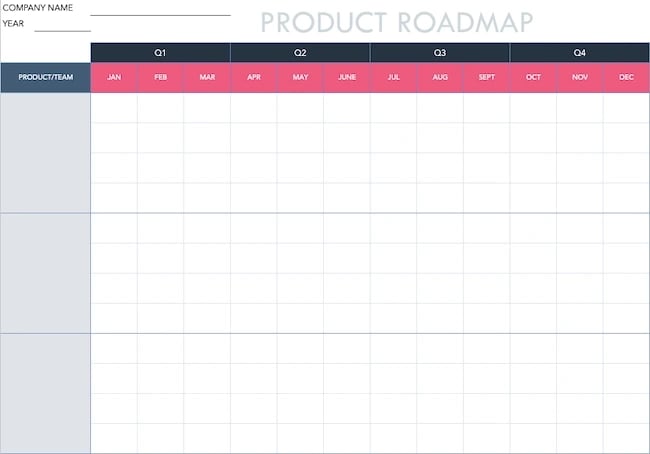
Each template has its own unique purpose, but they are best utilized in tandem:
-
Product Launch Planning Template: Create tasks that need to be completed for the product launch, provide progress updates, and plan social media and PR messaging
-
Product Update Email Templates: Internally communicate product updates and changes to your team
-
Product Roadmap Template: Create a schedule of all the tasks that will be addressed and who will be handling them
-
Product Lifecycle Mapping Template: Keep track of your product’s lifecycle stages
-
Product Classification Template: Classify your product and align all teams on product vision, marketing plan, and sales strategy
-
SWOT Analysis Template: Determine your product’s strengths, weaknesses, opportunities and weaknesses, as well as conduct market research on competition
-
Sales Plan Template: Outline and communicate sales strategy to stakeholders
2. Identify the buying center and personas.
When preparing your product for market, you must always consider your customer.
According to Gartner, the typical buying group for a complex B2B solution involves six to 10 decision-makers. These people make up what is called the "buying center."
Each of those buyers typically fills one of the following roles (though it’s important to note some job titles might occupy more than one role):
-
Initiator: Starts the buying process or shows initial interest
-
User: Uses your product regularly
-
Influencer: Convinces others the product is needed
-
Decision maker: Gives final approval for the purchase
-
Buyer: Owns the budget
-
Approver: Final approver who pushes the initiative on a larger scale (typically someone in the C-suite)
-
Gatekeeper: Blocker in getting a product implemented or approved
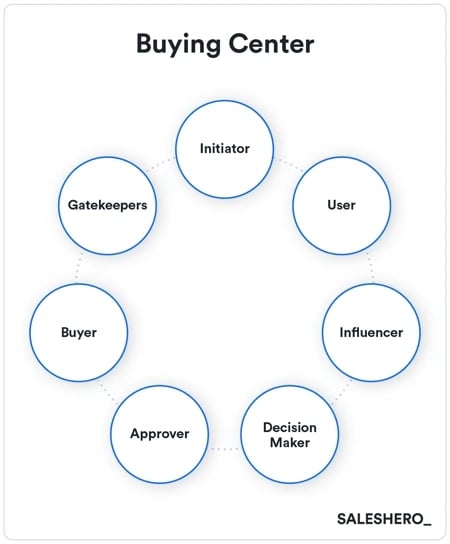
These roles vary based on the product, industry, and vertical you’re selling to. I recommend getting your team together to brainstorm the job titles that could be impacted by your solution.
I recommend researching each role to get a general sense of what they do, their goals, and their pain points. Learning who these people are, what motivates them, and what their problems are is critical as they will be the ones to put your product on the map.
Using Automation Hero as an example, the buying center breaks down like this:
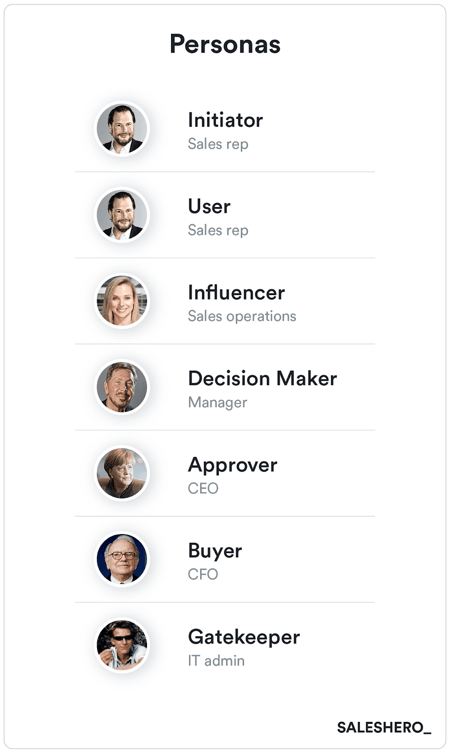
3. Craft a value matrix to help identify messaging.
After mapping your buying center personas, it’s time to map out your value matrix.
A value matrix is a breakdown of each buying center persona, their business problems, and how your product is valuable in solving those problems.
The value matrix will also include a relevant marketing message tying the problem and solution together.
Create a chart with each persona in one column. Below each persona, list the pain points they face daily. If your product can solve or ease any of these problems, include them in a row below.
Lastly, the message needs to capture the pain point and value in a meaningful way. The best way to achieve this is to agitate the pain point. People will take a painkiller to cure a headache but are much less likely to take a daily vitamin to prevent the pain in the first place. The value your product brings should solve the pain, not act as a vitamin.
Here's a fill-in-the-blank chart you can use to create a value matrix:
| Persona Name |
Pain Points |
Product Value |
Message |
| Example Eddy |
A process he uses costs too much time and money |
The service costs less time and money. |
This service does ____, which saves companies time and money. |
| |
|
|
|
| |
|
|
|
| |
|
|
|
Here’s an example of a complete value matrix:
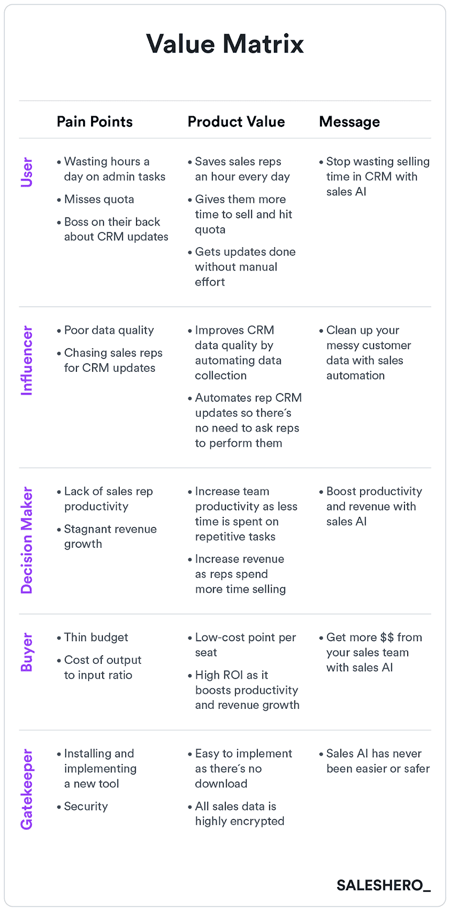
4. Test your messaging.
Once your value matrix is in place, it’s time to test your messaging. Start advertising on marketing platforms using the messages you’ve just created for various audience members.
You’ll have three variables to test: the channel you advertise on, your target audience, and the message you share.
When deciding where to test, I would first consider where your audience already spends their time and go there. Some possible paid digital ad channels might be LinkedIn, Google Ads, Facebook, and Twitter.
Once you run your tests, aim to continue advertising on the channels that show high conversions.
5. Optimize your ads based on the results of your tests before implementing them on a wide scale.
Next, optimize your audience. Some ad platforms have highly targeted audience settings for advertisers. For example, LinkedIn offers options for job title, job function, company size, and geographic location. Test different options to see who is more likely to click or convert.
For example, I noticed high clicks in certain industries, so we began targeting and using our ad budget to focus on that handful of industries on LinkedIn. The key here is spending money where you’ll get the biggest return on investment.
And, since you’ll be testing your message to see which versions resonate most with your audience, engagement and conversion rates of your ads will indicate which value proposition and pain points work best.
Using a dedicated marketing analytics tool here is also highly recommended, as it gives you insights into how the target audience behaves across different channels.
For instance, you can gather data on how users landing on your website from PPC ads interact with your pages, as well as compare PPC performance to other traffic sources.
Once you’ve collected this data, you can base your larger campaigns on these insights.
6. Understand your buyer’s journey.
With your personas and value matrix built, dive deeper to understand the journey a potential customer will take, both from the buyer’s perspective and your company's perspective.
From your customer’s perspective, the buying process is linear. More or less, it will go like this:
- The buyer realizes they have a business problem and researches the topic.
- The buyer shortlists potential solutions.
- That list is narrowed down by talking to sales teams from the solution provider and by testing product use cases until a decision is made.
The buyer’s journey — from a business perspective — used to be a funnel. In the traditional sales funnel, there is a lot of general interest at the top. It gradually narrows down as opportunities fall out of the pipeline.
This journey was divided into three sections:
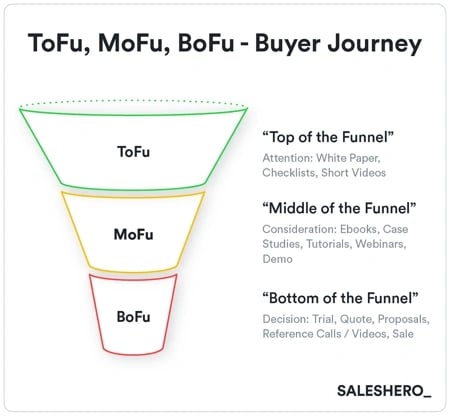
But the sales funnel is no longer the best way to look at your buyer’s journey. Instead, I propose using the flywheel methodology, which takes a more holistic approach that puts your customer at the center and turns your leads from prospects to customers to active promoters.
In the flywheel model, customers go through three stages: attract, engage, and delight.
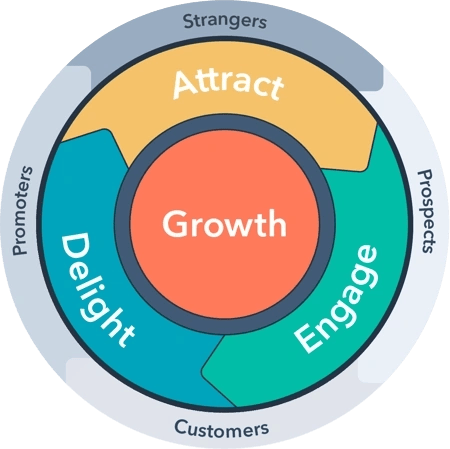
First up is the attract phase. Content at this stage grabs a potential customer’s attention. This can be in the form of a blog, whitepaper, or video. A lead gets here by clicking on an ad, social media post, or a search engine result. However, these behaviors do not indicate that this lead is ready to make a purchase yet.
After that comes the engage phase. In this stage, a prospect has demonstrated they have a problem your product can solve. They show this through digital behavior like downloading an ebook or joining a webinar, allowing you to engage them with educational content.
While each company divides the lead generation and qualification process differently, marketing is typically in charge of the attract and engage phases. Your marketing team will need to generate interest and awareness and educate the relevant audience on a product’s value through messaging and content (more on that later).
Halfway through the engagement phase, the prospect should ask for a quote or a trial period. They’re nearing a decision on whether or not to purchase.
Once the prospect reaches this point, the sales team takes over. I find process typically looks as follows:
-
Contact: Communication between the lead and sales rep begins.
-
Qualification: The sales rep learns more about the company, their customers’ pain points, and asks questions to see if they meet the basic requirements to purchase the product (BANT is a popular sales qualification method but several other sales methodologies are used to qualify).
-
Business case: The prospect tests the product through a free trial or POC to see if it can solve their needs.
-
Evaluation: The decision-makers in the organization weigh the cost of the product to the results they achieved during the business case.
-
Negotiation: Both sales reps and decision-makers discuss pricing details and feature needs.
-
Close: A deal is agreed upon and your prospect turns into a customer.
-
Renewal (Optional): Your customer renews their contract or subscription.
Right after your sales representative closes the sale, the lead leaves the engage phase and enters the delight phase. When customers reach this stage, they should be delighted by a painless onboarding process and friendly customer service options.
After that, your customer should ideally turn into a promoter. They bring you more customers, keeping the flywheel going and enabling you to grow better.
7. Choose one (or more) of the four most common sales strategies.
You’ve done all the required foundational work; now it’s time to pick a strategy that will push your product into the market. No one method will work for every product or market, so it’s important to consider the complexity, scalability, and cost of yours.
There are generally four go-to-market sales strategies — each one catering to a different product and business model.
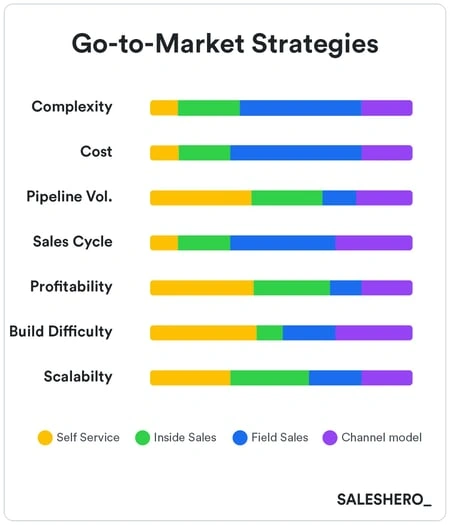
The Self-Service model
The self-service model is when a customer purchases on their own. We typically see this model with B2C purchases in which a customer can find and buy a product via a website, like Amazon.
This works best for simple products with a low-cost point and high sales volume. It can be difficult to build, but when successful, it sees a short sales cycle, zero cost to hire salespeople, and is highly profitable.
While you won’t need a sales team, you will need a marketing team to drive traffic and conversions to your site. The core marketing team would likely include growth marketing, performance marketing, and content marketing experts, though there will likely be other team members as well.
The Inside Sales Business Model
The inside sales business model is when a prospect needs to be nurtured by a sales rep to convert into a deal. This type of model works best with a product of medium complexity and price.
The sales cycle ranges between a few weeks and a few months. Here, you’ll invest in a sales team — but inside sales reps are less expensive than field reps.
With a high volume of sales, this model can be profitable and is fairly easy to build and scale as you hire more team members. The sales team in this model is typically composed of a sales manager who supervises a handful of reps.
The Field Sales Business Model
The field sales business model is when you have a full sales organization that closes large enterprise deals. These are typically complex products with high price points, which also means there’s typically a low volume of deals with a long sales cycle.
The sales team in this model is often very costly as the field reps are experienced, high-salary employees. This model is easy to build but harder to scale because hiring and training a full sales organization takes time and money.
Members include a sales manager, field reps, sales engineers, a sales development representative (SDR) team, and sales operations.
The Channel Model
Lastly, in the channel model, an outside agency or partner sells your product for you. This is hard to build, as the people can be difficult to recruit and educate on the benefits of your product. They are also often less motivated to sell than your own sales team would be.
However, this is a cheaper model because you don’t need always to pay a sales team of your own. I find that it works best with a product that matches the partner’s interest. For example, if you sell phone cases, you might want to find partners selling related products, like Best Buy or Apple.
You can mix and match these strategies based on industry or customer size (i.e., number of licenses or seats). For startups, it’s healthy to scale over time rather than invest in an expensive sales team too early.
8. Build brand awareness and demand generation with inbound and/or outbound methods.
Now, you need to fill your pipeline by snagging the attention of your target audience. This occurs through demand generation, which can happen with both inbound and outbound strategies.
With inbound, prospects discover your brand through marketing efforts and reach out to you or show signs of interest organically. Some examples of organic inbound traffic channels could be social media, content, or paid ads leading to a landing page.

Outbound demand generation is when a salesperson contacts a lead through cold outreach tactics. They might do this by reaching out to a contact list, sending warm emails, phoning leads, or gathering leads at industry conferences.
Once interest has been generated through these methods, sales conversations begin, and the leads are led to more educational content and then into the sales funnel.
9. Create content to get inbound leads.
Inbound leads are generally easier to convert and cheaper to acquire than outbound leads. This is because inbound leads are already partially educated on the business problem you solve, aware of your product, and usually more interested in buying your product.
Content marketing is the key to generating that inbound interest, as content will drive traffic to your site.
Your content marketing team will drive this inbound traffic by finding and targeting keywords that your potential customers would search for and then creating and posting related content on your website.
At the core of content marketing is search engine optimization (SEO), which is the way a search engine ranks the content on the internet once a query is entered into the search bar. This will be a large source of your organic web traffic.

What goes into content marketing? It’s a cycle of keyword research, creation, and measurement.
-
Keyword research: Identify keywords related to your product, analyze the volume (how often that keyword is searched), the difficulty of ranking for that keyword (i.e., how competitive that keyword is), and see who is already ranking for those keywords.
-
Content research: Brainstorm content topics that include that keyword. See what articles already exist around these topics and begin to plan your content calendar.
-
Content creation: Put those ideas into motion and have a writer create articles on those topics.
-
Design: Add relevant images, infographics, videos, and other multimedia to your content so it’s more visual and engaging.
-
Promote: Spread your content and drive traffic to your website by sharing the links via social media or emails to your customer database.
-
Build links: Reach out to other publishers and ask them to link to your content to gain even more traffic with link-building tactics. This gives you site authority, which helps improve your SEO rankings.
-
Conversion rate: Track and measure the engagement and conversion rates of your content. Keep doing what works and drop what doesn’t. From there, begin the content creation cycle again.
Your content team should develop content that aligns with the various stages of the buyer’s journey (top-of-funnel, middle-of-funnel, bottom-of-funnel).

Top-of-funnel content is lighter educational content, middle-of-funnel content is deeper, more applied learning, and bottom-of-funnel content is for those who are ready to buy and implement. To use SalesHero as an example, the content at each level of the funnel would look like this:
-
Top-of-funnel content: "What is sales AI?"
-
Middle-of-funnel content: "How sales AI can increase productivity"
-
Bottom-of-funnel content: "Using sales AI to extract dark data"
To make this process easier (and more organized), I recommend creating a messaging strategy or content marketing plan based on your customer's journey and the knowledge they do (and don’t) have at each stage.
Below, I’ll share an example of how you can organize your content, and you can easily fill in my chart when creating your own.
Top-of-Funnel Content
Funnel Stage: Awareness
Flywheel Goal: Attract Prospects
What type of content will you create to catch the eye of potential customers in similar industries? Make a table like the one below.
| Type of Content |
Topic |
Promo Strategy |
Lead Generation |
| Blog post |
What is sales AI? |
Content will be shared on Facebook, Twitter, LinkedIn, and in weekly newsletter. |
A CTA in the post will ask readers to sign up for our next webinar. |
| |
|
|
|
| |
|
|
|
Middle-of-Funnel Content
Funnel Stage: Consideration
Flywheel Goals: Attract and Engage Leads
In this phase, your audience might know of your service or be researching products related to yours. What types of content do you create to move your service to the front of their minds?
| Type of Content |
Topic |
Promo Strategy |
Lead Generation |
| Webinar |
How Sales AI Can Increase Productivity |
Social and email promotion will link to the signup page. |
A thank you email will include a link to request a demo. |
| |
|
|
|
| |
|
|
|
Bottom-of-Funnel Content
Funnel Stage:strong> Decision
Flywheel Goals:strong> Engage and Nurture Leads / Gain and Delight Customers
Your audience is really interested in your service. How will you use content to sell them?
| Type of Content |
Topic |
Promo Strategy |
Lead Generation |
| Demo or tutorial |
Use Our Sales AI Tool to Extract Dark Data |
Demo signup links will be shared in webinar follow-up emails, newsletters, and on the website. |
Those entering demos will make contact with a direct sales/support person. |
| |
|
|
|
| |
|
|
|
1. Find ways to optimize your pipeline and increase conversion rates.
Growth requires more than simply picking a sales strategy and building a demand generation process. You must optimize.
Sales is a numbers game, and you can only be successful if you measure progress. The key performance indicators (KPIs) for managing a sales team are volume, conversion rate, and time.
You’ll also want to track how many opportunities come into the flywheel: your pipeline volume.
Then track how many leads turned into customers. Comparing the volume of the pipeline opportunities to the number of won deals will get you your overall conversion rate.
It’s found that it's even more important to optimize the conversion rate between stages. As opportunities move through the funnel, they’ll go through various qualification processes (i.e., basic qualifications, current solutions in use, technical evaluation, and closing), and you’ll want to track at which stage the opportunities fall out and why.
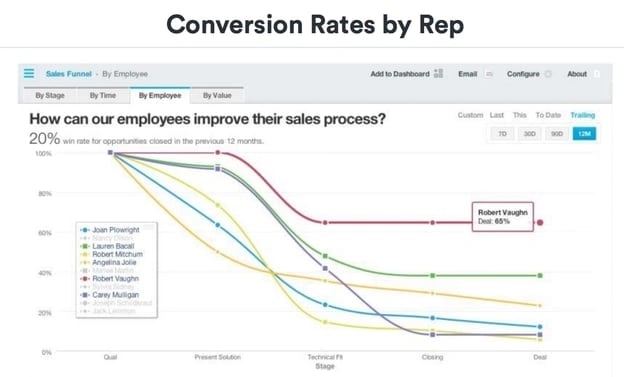
I recommend measuring this for your overall flywheel and per sales rep. This information tells you where each rep needs to improve and potentially receive more training. Work to personalize your sales coaching efforts to shorten the sales cycle of each rep. Compare time and conversion rate to see who's better and faster in particular stages.
Track how many opportunities each rep converts and at what stage in the process they drop out. The sooner an unqualified opportunity falls out of the flywheel, the better, because less time, energy, and resources are spent on that particular lead.
2. Analyze and shorten the sales cycle.
Finally, track how long your sales cycle is. This is the amount of time it takes for an opportunity to enter the sales funnel and change to a closed/won deal. The goal is to shorten the conversion between every stage. This can be done by identifying common objections (and iterating ways to remove them before they happen), doing ongoing lead nurturing, and brainstorming ways to find the best-fit customers.
3. Reduce customer acquisition costs.
As a business owner, you’ll also need to optimize your customer acquisition cost. This will be very expensive at first, but as time goes on, you’ll need to reduce this cost by optimizing your processes, or you’ll be losing more money than you make.
Customer acquisition is how much it costs to gain a new customer or deal per $1. The lower the customer acquisition cost, the lower the impact your marketing efforts have on your PNL, and the higher the profit you get per customer.
4. Strategize ways to tap into your existing customer base.
A common adage in the industry is that it costs seven times more to acquire a new customer than it does to do business with an existing customer. If you're providing a great buying experience, existing customers already know, like, and trust you — all of which are reasons to stick around.
The best opportunity for companies to earn more and gain revenue is through renewals, cross-selling, and upselling. The average cost for a company to renew a product is $0.13, while upsells cost a company $0.28.
Many people think of sales as a black box. But with analytics and new sales AI technologies cropping up, business leaders can optimize their processes to accelerate business.
5. Adjust and iterate as you go.
Building a successful company is not reserved for those entrepreneurs who’ve been blessed with special skills.
Chances are, you’ve already built your product, and building a company is a very similar process. You must be strategic and continue to improve throughout the process.
Take time and continue to iterate, and you too can build a company. Return to areas of your plan that aren’t working and tweak them. Make note of the things that are working, and brainstorm ways to expand upon them.
6. Retain and delight your customers.
In this phase, you will focus on maintaining your customer relationships and spreading good word-of-mouth. This is where a flywheel strategy can be much more helpful than the funnel, which ends at sales. For a detailed rundown of the delight phase and beyond, check out this ultimate guide.
Although different products might require different launch strategies, the below template and steps should help you create a solid starter plan which can be customized along the way.
Go-To-Market Plan Template
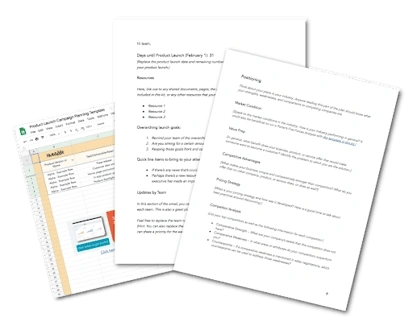
Download Now
Creating a go-to-market strategy from scratch can be daunting — especially if it’s your first time launching a brand-new product or service. That’s why HubSpot created a complete go-to-market kit to help you get started. You’ll find templates that help keep your team on schedule and promote alignment between all product stakeholders.
The kit includes:
- Product Launch Planning Template
- Product Update Email Templates
- Product Roadmap Template
- Product Lifecycle Mapping Template
- Product Classification Template
- SWOT Analysis Template
- Sales Plan Template
Still stumped? Below, I’ve included a few more examples of go-to-market strategies that can help you inspire your own.
1. Via
Via is a ridesharing platform that was founded in 2012 when Uber was still relatively unknown.
While Uber has bypassed Via in popularity and product usage, Via has effectively carved a niche in the transportation technology space.
Why I Think Via’s Go-to-Market Strategy Works:
The company’s GTM strategy emphasized ride-sharing — that is, riders literally share rides with other riders traveling in the same direction. The driver takes a predetermined route and drops riders off at convenient locations rather than picking up riders at private locations.
Via set out to solve a common pain point for commuters: overcrowded or unavailable public transit with inflexible routes.
Another pain point of the target audience was that Uber and Lyft rides were overpriced and couldn’t be used for daily commutes. Via looked at this problem and created a true ridesharing service that could fill the space Uber and Lyft didn’t fill.
Now, the company partners with private transit operators, schools, and public transit agencies to expand existing operations or provide more riding options for passengers. The result of Via’s go-to-market strategy is that it no longer sees Uber as a direct competitor.
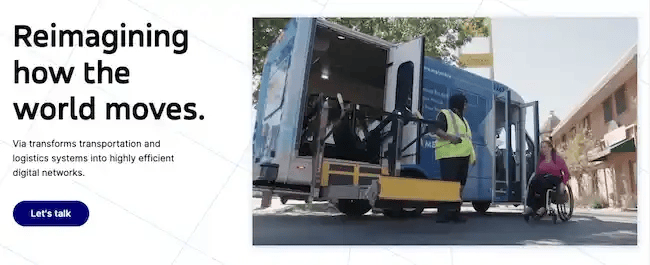
2. Microsoft Surface
Microsoft Windows has long been the preeminent OS, and for good reason: most computer manufacturers offer Windows laptops and desktops.
So why would Microsoft launch its line of computers and tablets if its software is ubiquitous?
Why I Think Microsoft Surface’s Go-to-Market Strategy Works:
In its go-to-market strategy for its Surface products, Microsoft set out to solve a common problem for tablet users. Tablets were primarily mobile devices; while they were convenient to carry, they didn’t offer the full functionality of a laptop. And for many people, owning both a tablet and a laptop was not financially feasible.
When it released the third generation of the Surface tablet, Microsoft made its position clear. The device was a fully functioning computer in tablet form. You could have a light device without sacrificing function. Compared to the Apple iPad, its principal competitor, the Surface tablet offered more functionality at the same price.
Now, the Microsoft Surface line has expanded to include laptops and desktops. Microsoft realized that laptop buyers may not purchase a Windows laptop because there are so many manufacturers to choose from. Specifications and hardware components vary from machine to machine.
With its Surface laptops, Microsoft makes the choice easier for target demographics such as college students and everyday users. These devices compete with Apple’s macOS offerings and are designed to seamlessly integrate with all of the features of Windows OS.
3. Owala
At first glance, the Owala brand of water bottles doesn’t seem much different from competitors.
But in its go-to-market strategy, the brand used its motto, "Do more of what you love," to hint at its products’ ease of use. You can "do more of what you love" since you won’t even waste time opening the bottle. The lid itself is where you sip.
Why I Think Owala’s Go-to-Market Strategy Works:
With its product launch, Owala addressed common problems for water-drinkers: openings that are too wide, spills, and two-handed drinking.
Owala specifically targets those who are active. In its first series of Instagram posts, the brand posted a mosaic of a man on a motorcycle, and in most of its social posts, it includes people in workout clothes.
The company arguably entered an overcrowded space. Brands such as HydroFlask and Contigo dominate the industry. By addressing a specific target buyer and solving their problems, however, Owala successfully launched into that competitive market. The brand distributes its offerings through its website, BestBuy, and Amazon for optimum reach.
4. Bread Beauty Supply
Bread Beauty Supply, a Black- and woman-owned hair care line, set out to solve a common problem for its curly-haired audience: overcomplicated routines that waste time, energy, and products.
Why I Think Bread Beauty Supply’s Go-to-Market Strategy Works:
The brand launched in 2020 and partnered with Sephora as its principal distribution channel. In its go-to-market strategy, the brand identified a segment of buyers who would rather keep their routine simple and leave their curls in their natural state.
Compare this strategy with that of competitor brands such as Pattern Beauty and Ouidad, both of which offer a multitude of hair care products that can dizzy, confuse, and overwhelm buyers. When creating its go-to-market plan, Bread Beauty Supply recognized that some people with curly hair would rather spend less, not more, time on their hair.

Image Source
While the curly hair care industry verges on overcrowded, Bread Beauty Supply successfully launched by taking a unique stance in the industry.
5. The Sip
The Sip, a Black- and woman-owned champagne subscription service, makes drinking luxury wine more affordable.
Champagne clubs have always been around, offering monthly deliveries of delectable wines at a premium cost.
To the target audience, however, this model poses a few problems. The wine of choice for that month could fail to meet expectations, and that could result in a wasted bottle. And that is at full cost, too. One of The Sip’s competitors, Club Bubbly, charges $100 per month to deliver two bottles of champagne.
Why I Think The Sip’s Go-to-Market Strategy Works:
In its go-to-market strategy, The Sip emphasized its mini-bottle program: subscribers can try three mini-bottles of champagne at a fraction of the cost. If you happen to like one, you can buy the full bottle.
By solving common problems faced by subscribers of wine boxes, The Sip not only attracted the subscribers of its competition, but opened up this type of subscription to buyers who could not previously afford it.
6. Vuclip
Vuclip, a mobile video-on-demand service, tapped into emerging markets with limited access to high-quality video streaming services. Consumers in these areas — including India, Thailand, and Egypt — dealt with slow video buffering speeds due to a lack of advanced mobile networks.

Image Source
Why I Think Vuclip’s Go-to-Market Strategy Works:
The company's go-to-market strategy rested on appealing to those "must-have" markets, where it could come in with a competitive advantage by presenting an accessible platform that addressed those regional consumers' issues with buffering.
The result? Vuclip built a subscriber base of more than 41 million consumers across over 3,000 cities, with plans to establish a presence in even more underserved markets around the world.
7. Upscope
Upscope, an interactive screen sharing platform, came on the scene as a resource to suit a more technically inclined crowd than its competitors — namely onboarding, support, and IT specialists.
Why I Think Upscope’s Go-to-Market Strategy Works:
The primary pain point the company looked to address was the trouble consumers ran into when trying to share their screens — particularly when it came to walking prospects, customers, or employees through technical subject matter.
The company addressed that issue by creating a solution that lends itself to instant and interactive screen sharing — sparing users the trouble of fumbling through the screen share process and letting all parties engage with the content they're seeing.

Image Source
Upscope supported its go-to-market efforts with a solid content marketing strategy — maintaining an active web presence and blog. It also incorporated integrations with other tools into its solution, giving itself more visibility and clout.
8. Baggu
Baggu is a reusable bag brand. While it seems rather simple on the surface, its go-to-market strategy has made a buzz in the world of sustainability.
Why I Think Baggu’s Go-to-Market Strategy Works:
This brand was created to eliminate unnecessary waste through responsibly managing deadstock products and fabric. This appeals to eco-conscious consumers who are trying to minimize their use of plastic bags.
Accompanying its relatable mission, Baggu has held many collaborations that take its products from functional, to stylish statement pieces.
Baggu recently partnered with Joonbug, a Jamaican artist known for impressive skate designs, and made colorful patterns that showcase his cultural roots and style.

Image Source
The products are visually interesting, eye-catching, and were marketed through Instagram — a social media platform designed for visual ads and promotion, and a perfect vehicle for a mutually beneficial collaboration for JoonBug, who is also a prominent influencer in the art sphere.
9. Thinx
Thinx is a feminine hygiene company that makes underwear for people with periods. This re-imagined approach to menstrual products has been gaining more traction in the industry, and its go-to-market strategy has definitely aided in its success.
Why I Think Thinx’s Go-to-Market Strategy Works:
A common pain point for people with periods is spending a lot of money on one-time hygienic products, and it’s not good for the environment, either. So offering washable underwear with a 2 year guarantee is a much better investment than the alternative.
Thinx is also known for partnering with organizations using cause marketing, like with Black Mamas Matter Alliance. BMMA focuses on the issue of maternal health (specifically for black women who are three times more likely to die from childbirth than other races) that Thinx’s audience would also care about or be aware of.
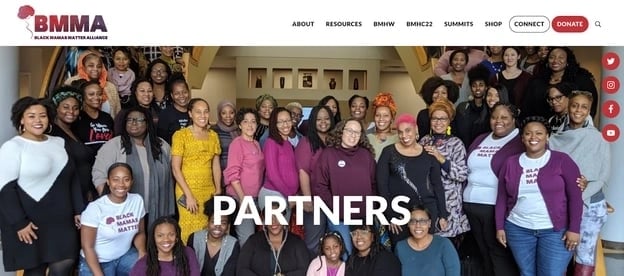
Image Source
This strategy appeals to consumers who can feel good knowing they're buying something that gives back a portion of profit to something beyond themselves, especially if it raises awareness of inequalities in maternal health.
10. Metaverse
One of the most outlandish ideas of recent go-to-market strategies is none other than the launch of the Metaverse. It’s an immersive, digital economy made by Facebook, and a look into the future for the platform.
Why I Think the Metaverse’s Go-to-Market Strategy Works:
This brand understands that people are leading digital lives more than ever, which includes more online shopping — but without the experience of shopping in person. So while it is more convenient to add items to your cart through clicks, customers give up the feel of shopping in store.
Metaverse solves for this, by incorporating the brick and mortar experience in a VR-centric, digital world.

Image Source
In addition to solving the online shopping dilemma, the PR campaign and influencer marketing was such a huge rollout on one of the most major social media platforms, it caused quite a buzz through the internet and news outlets.
Create a Strong GTM Strategy for Your New Venture
Building a go-to-market strategy is critical before bringing your new product to market. With the steps I shared in this guide, you’ll be well on your way to launching a product or service that solves for your future customers and becomes profitable in the marketplace.
Editor's note: This post was originally published in November 2019 and has been updated for comprehensiveness.










































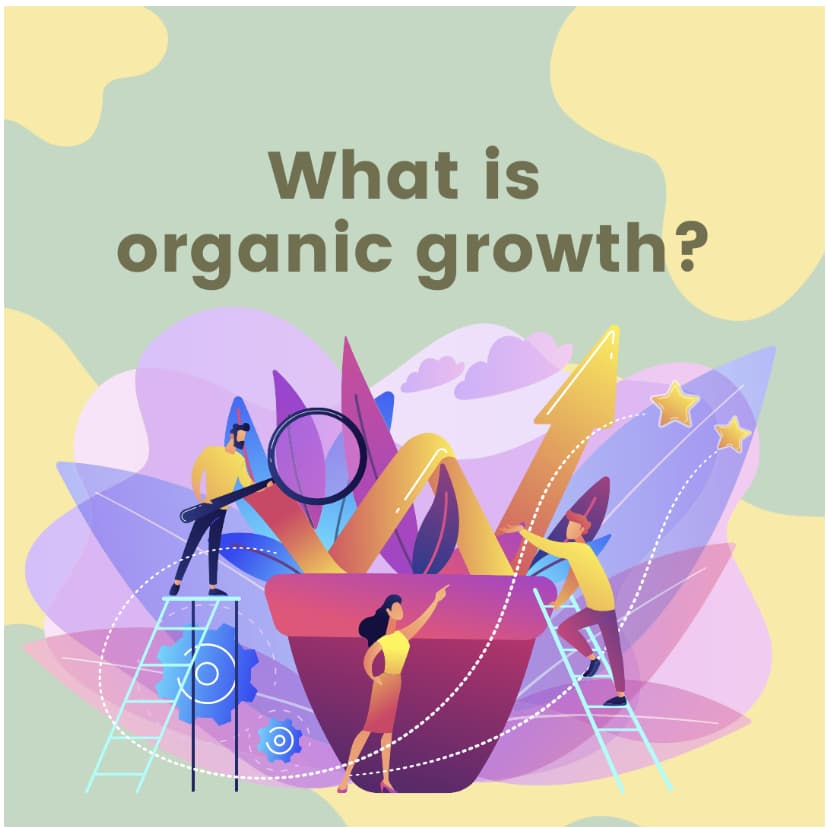
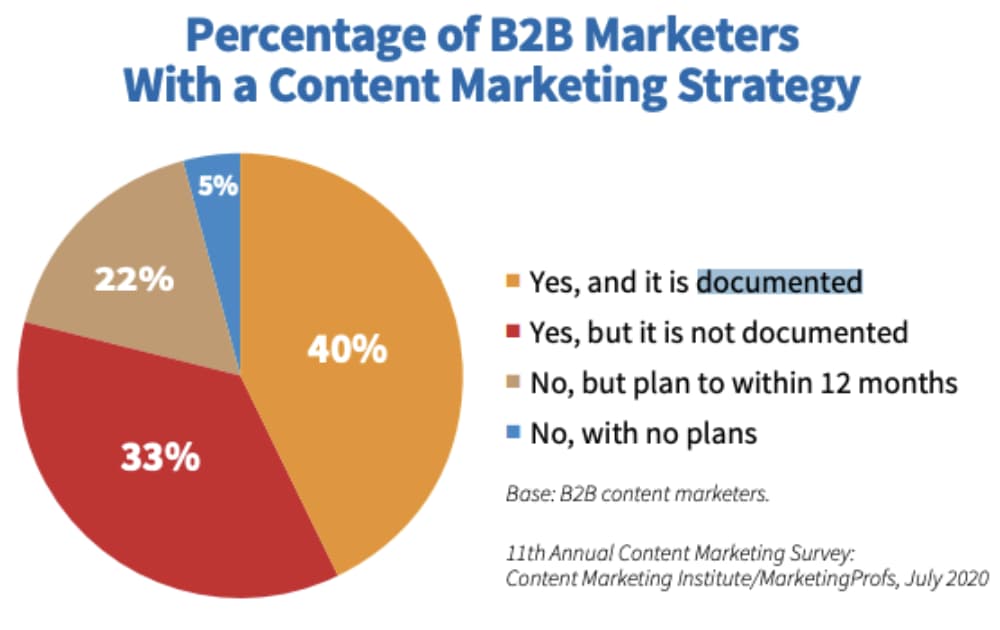
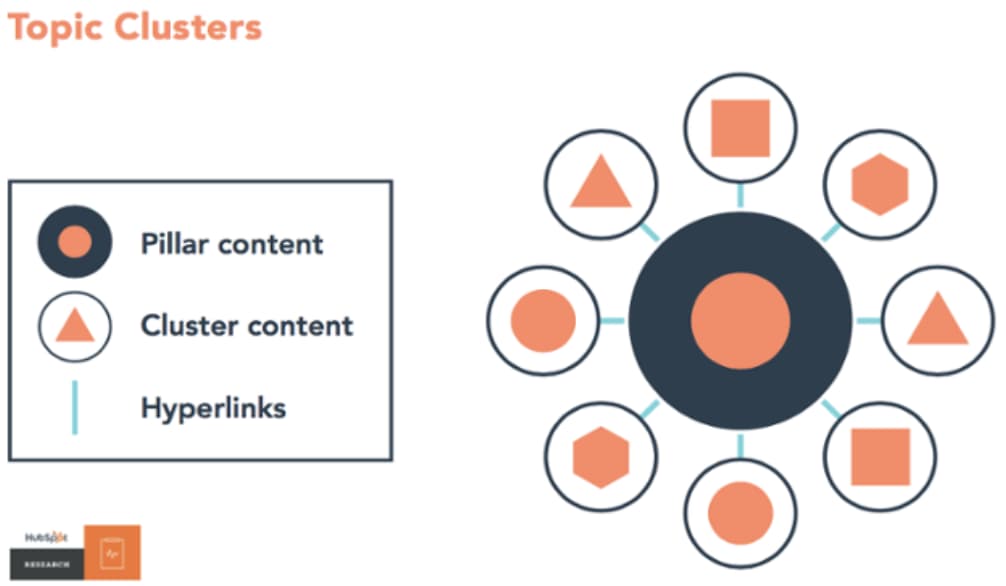

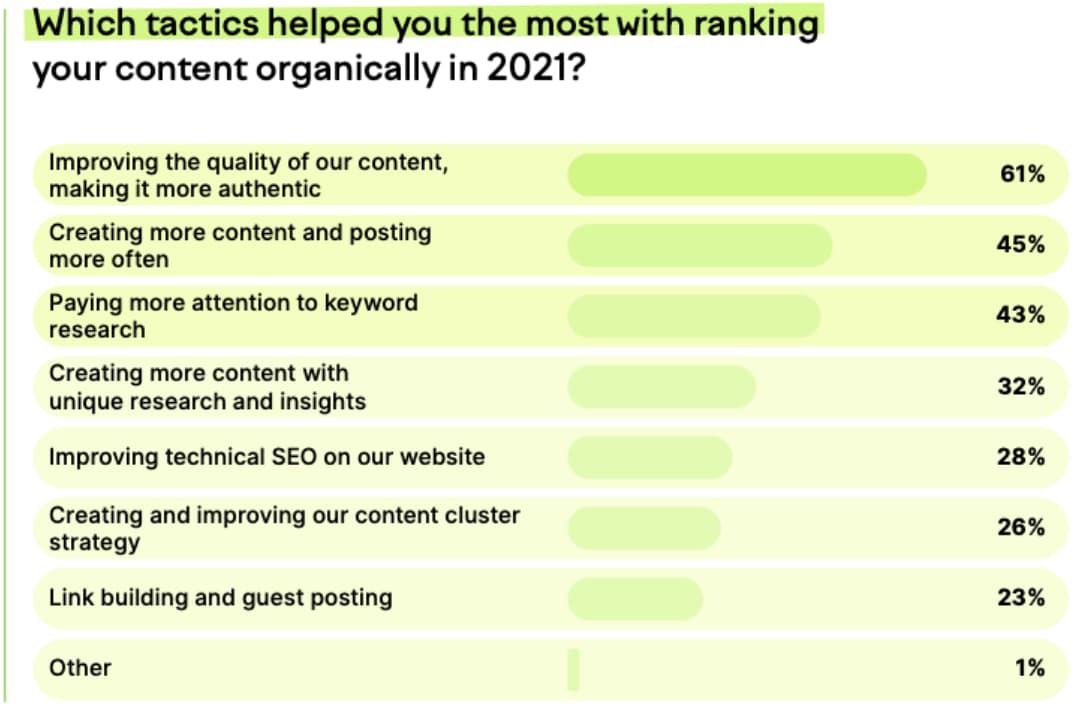

![→ Download Now: Free Product Marketing Kit [Free Templates]](https://no-cache.hubspot.com/cta/default/53/08b5e1f4-5d26-405b-b986-29c99bd0cb14.png)




















 symbol. When in doubt, skip the jargon and explain the product in plain English.
symbol. When in doubt, skip the jargon and explain the product in plain English.

 F
F
 Blake didn’t understand what we do today about the sales process. It’s not about what we want. As sales professionals, our purpose is to give people what they want. The thing that benefits them.
Blake didn’t understand what we do today about the sales process. It’s not about what we want. As sales professionals, our purpose is to give people what they want. The thing that benefits them.






















